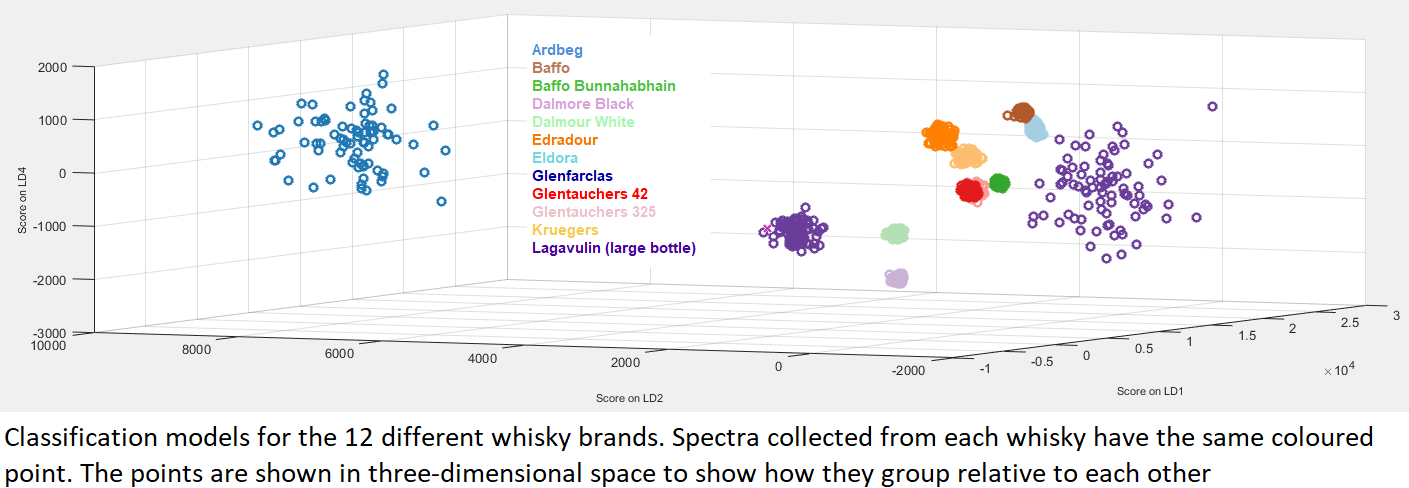Many consider whisky as an acquired taste. For its advocates, however, whisky offers the opportunity to experience and enjoy a range of complex flavors on the palate. From the spelling to the origin, whiskies are widely debated by enthusiasts around the world. What is universally agreed-upon, in their long history, is their uniqueness, in which their in-cask aging has a great deal of influence on the smell and taste.
The value of whisky – perhaps like all collectable products – simply increases with rarity and time. Some whiskies (such as older single malts) can be priced in excess of £50,000. Like all desirable and unique products, it is perhaps inevitable that this sum attracts the interest of forgers. It was estimated by Rare Whisky 101 that “£41 million worth of fakes were circulating on the rare whisky scene in 2019” (1).
It is therefore logical that, with such sums of money involved, an objective, scientifically robust, method to evidence the product’s origin and authenticity are vital to ensure that diluted/mixed products - or even counterfeits - are identified.
This article records how the inViaTM confocal Raman microscope was used to analyze a variety of whiskies through unopened, sealed bottles in order to evidence their authenticity.

Image Credit: Renishaw plc - Spectroscopy
Raman Analysis of Whisky
Both non-destructive and non-contact, Raman spectroscopy provides detailed chemical information on the range of chemicals that are contained within a mixture. Extreme chemical specificity is provided to a certain combination of produced chemicals, through the "fingerprint" of its assocciated Raman spectrum. The whisky "fingerprint" could be collected through the unopened bottle, and then checked against other known varieties to confirm its authenticity.
To collect spectra from 12 different whisky brands, an inVia Raman microscope was used. A macro lens with 90° adapter was used to focus through the glass of an unopened bottle. The bottles are also made up of different-colored glasses. From each known authentic whisky brand, multiple Raman spectra were collected.

Image Credit: Renishaw plc - Spectroscopy
Dedicated classification software was used to support the inVia Raman microscope, in which varieties purported to be equivalent were compared with data from known varieties (termed gold standards). A classification model was generated from the Raman spectra from each gold standard whisky.
Raman Whisky Spectrum
Principal component analysis with linear discriminate analysis (PCA-LDA) was deployed to group spectra based on spectral features unique to each whisky brand. A plot where each whisky brand has a spread of points, showing how each can be objectively differentiated, was the result.

Image Credit: Renishaw plc - Spectroscopy
Brands: Raman Whisky
The process of spectrally distinguishing each whisky can be shown by the classification (group of colored points), with any intra-brand spectral variation shown by multiple points. Fantastic specificity is provided by this method, even where the spectral differences are very subtle.
Subtle changes from dilution or mixing with other varieties can be revealed by this approach. Similar approaches with Raman spectroscopy are being developed to classify biological fluids and tissues to diagnose disease, with even more complex bio-chemical systems.
In order to determine the brand using the Renishaw Data Classifier, a bottle of whisky was then supplied. A single spectrum was collected in 10 s which classified the whisky as Lagavulin, when it was actually presented in a bottle from the Ardbeg brand. Despite the fact that the Ardbeg bottle was made of a different colored glass (green) compared to the Lagavulin, the whisky was accurately identified. This experiment underlined the accuracy and efficiency of the Raman and PCA-LDA technique, as it produces rapid and precise identification of the bottle contents.

Image Credit: Renishaw plc - Spectroscopy
Classification: Raman Whisky
This accuracy and speed are contributing factors to the success of the inVia Raman microscope, which has been used by whiskyauction.com, a major German auction house of rare and unique whiskies, to prove and demonstrate the authenticity of its products.
So, if you are a whisky drinker, think about the detailed chemistry and use of modern technology behind your favorite tipple the next time you take a sip. If you want to know more about the technology, please feel free to visit www.renishaw.com/ramanapplications to check out more other articles.
Acknowledgments
Produced from materials originally authored by Tim Smith from Renishaw. Thanks to Marc Richter (Renishaw GmbH), for his valuable contribution supplying the data and data analysis.
References
- How to spot a fake whiskey - Decanter

This information has been sourced, reviewed and adapted from materials provided by Renishaw plc - Spectroscopy.
For more information on this source, please visit Renishaw plc - Spectroscopy.